Spring – REST JSON Response
Last Updated :
03 Mar, 2022
REST APIs are becoming popular for the advantages they provide in the development of applications. REST APIs work like a client-server architecture. The client makes a request and a server (REST API) responds back by providing some kind of data. A client can be any front-end framework like Angular, React, etc, or Spring application ( internal/external ) itself. Data can be sent in various formats like plain text, XML, JSON, etc. Of these formats, JSON ( JavaScript Object Notation ) is a standard for transporting data between web applications.
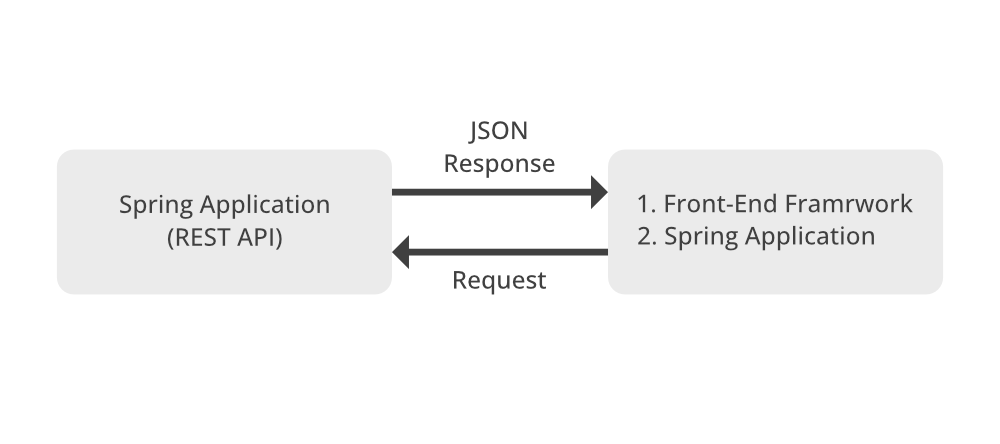
Pre-requisites required are as follows:
- JSON string can be stored in it own file with the ‘.json‘ extension.
- It has the MIME type of – ‘application/json‘.
JSON
JSON is an abbreviation for JavaScript Object Notation. It is a text-based data format following Javascript object syntax. It has syntax somewhat like a Javascript object literal and can be used independently from Javascript. Many programming environments have the ability to parse and generate JSON. It exists as a string and needs to be converted into a native Javascript object to access the data by available global JSON methods of Javascript.
Structure of the JSON
{
"id" : 07,
"framework" : "Spring",
"API" : "REST API",
"Response JSON" : true
}
On sending an array of objects, they are wrapped in the square brackets
[
{
"id" : 07,
"name" : "darshan"
},
{
"id" : 08,
"name" : "DARSHAN"
}
]
- Spring framework’s ‘Starter Web’ dependency provides you with the two essential features of Spring MVC – (Spring’s web framework) and the RESTful ( REST API ) methodology.
- To include ‘Starter Web’ in the Spring application, add the following dependency –
Maven -> pom.xml
<dependency>
<groupId>org.springframework.boot</groupId>
<artifactId>spring-boot-starter-web</artifactId>
</dependency>
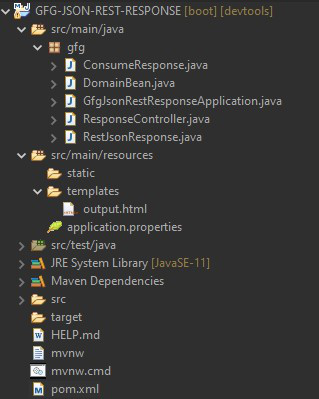
Project structure – Maven
File: pom.xml (Configurations)
XML
<?xml version="1.0" encoding="UTF-8"?>
<modelVersion>4.0.0</modelVersion>
<parent>
<groupId>org.springframework.boot</groupId>
<artifactId>spring-boot-starter-parent</artifactId>
<version>2.6.3</version>
<relativePath/>
</parent>
<groupId>sia</groupId>
<artifactId>GFG-JSON-REST-RESPONSE</artifactId>
<version>0.0.1-SNAPSHOT</version>
<name>GFG-JSON-REST-RESPONSE</name>
<description>REST API Response</description>
<properties>
<java.version>11</java.version>
</properties>
<dependencies>
<dependency>
<groupId>org.springframework.boot</groupId>
<artifactId>spring-boot-starter-thymeleaf</artifactId>
</dependency>
<dependency>
<groupId>org.springframework.boot</groupId>
<artifactId>spring-boot-starter-web</artifactId>
</dependency>
<dependency>
<groupId>org.springframework.boot</groupId>
<artifactId>spring-boot-starter-test</artifactId>
<scope>test</scope>
</dependency>
<dependency>
<groupId>org.springframework.boot</groupId>
<artifactId>spring-boot-starter</artifactId>
</dependency>
<dependency>
<groupId>org.projectlombok</groupId>
<artifactId>lombok</artifactId>
<optional>true</optional>
</dependency>
<dependency>
<groupId>org.springframework.boot</groupId>
<artifactId>spring-boot-devtools</artifactId>
<scope>runtime</scope>
<optional>true</optional>
</dependency>
</dependencies>
<build>
<plugins>
<plugin>
<groupId>org.springframework.boot</groupId>
<artifactId>spring-boot-maven-plugin</artifactId>
<configuration>
<excludes>
<exclude>
<groupId>org.projectlombok</groupId>
<artifactId>lombok</artifactId>
</exclude>
</excludes>
</configuration>
</plugin>
</plugins>
</build>
</project>
|
File: GfgJsonRestResponseApplication.java ( Bootstrapping of the application )
Java
package gfg;
import org.springframework.boot.SpringApplication;
import org.springframework.boot.autoconfigure.SpringBootApplication;
@SpringBootApplication
public class GfgJsonRestResponseApplication {
public static void main(String[] args)
{
SpringApplication.run(
GfgJsonRestResponseApplication.class, args);
}
}
|
File: DomainBean.java ( User properties – The data to be transferred )
- Java Beans requires the Getter/Setter methods.
- One can generate them automatically with the ‘@Data’ annotation of the ‘Lombok’ library.
- Dependency is as depicted below as follows:
Maven -> pom.xml
<dependency>
<groupId>org.projectlombok</groupId>
<artifactId>lombok</artifactId>
<optional>true</optional>
</dependency>
Java
package gfg;
import lombok.Data;
@Data
public class DomainBean {
String id;
String name;
String data;
}
|
File: RestJsonResponse.java ( REST API )
- This class provides RESTful services.
- Essential annotations are –
|
Annotation
|
Description
|
| @RestController |
Combines @Controller and @ResponseBody |
| @RequestMapping |
Maps web requests with ‘path’ attribute and response format with ‘produces’ attribute |
| @CrossOrigin |
Permits cross-origin web requests on the specific handler classes/methods |
| @GetMapping |
Maps GET request on specific handler method |
| @PathVariable |
Binds the URI template variables to method parameters |
Java
package gfg;
import java.util.ArrayList;
import org.springframework.http.HttpHeaders;
import org.springframework.http.HttpStatus;
import org.springframework.http.ResponseEntity;
import org.springframework.web.bind.annotation.CrossOrigin;
import org.springframework.web.bind.annotation.GetMapping;
import org.springframework.web.bind.annotation.PathVariable;
import org.springframework.web.bind.annotation.RequestMapping;
import org.springframework.web.bind.annotation.RestController;
@RestController
@RequestMapping(path="/JSON", produces="application/json")
@CrossOrigin(origins="*")
public class RestJsonResponse {
@GetMapping("/data")
public ArrayList<DomainBean> get() {
ArrayList<DomainBean> arr = new ArrayList<>();
DomainBean userOne = new DomainBean();
userOne.setId("1");
userOne.setName("@geek");
userOne.setData("GeeksforGeeks");
DomainBean userTwo = new DomainBean();
userTwo.setId("2");
userTwo.setName("@drash");
userTwo.setData("Darshan.G.Pawar");
arr.add(userOne);
arr.add(userTwo);
return arr;
}
@GetMapping("/{id}/{name}/{data}")
public ResponseEntity<DomainBean> getData(@PathVariable("id") String id,
@PathVariable("name") String name,
@PathVariable("data") String data) {
DomainBean user = new DomainBean();
user.setId(id);
user.setName(name);
user.setData(data);
HttpHeaders headers = new HttpHeaders();
ResponseEntity<DomainBean> entity = new ResponseEntity<>(user,headers,HttpStatus.CREATED);
return entity;
}
}
|
Outputs:
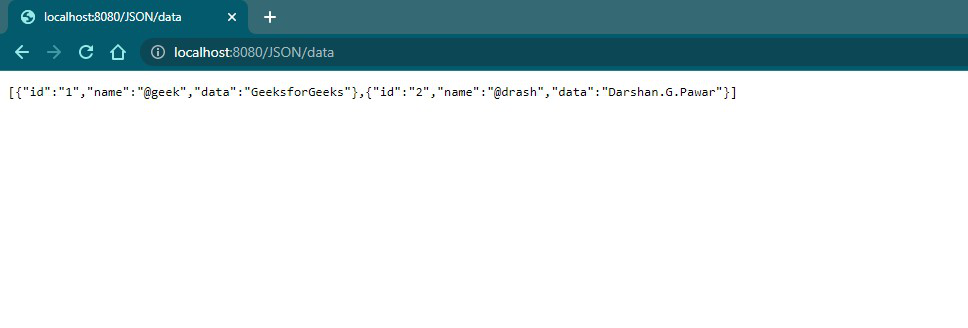
An array of JSON object literals

JSON object literal
REST API’s JSON response can be consumed by:
- Spring application itself.
- Front-end application/framework
A: Spring Application
- Spring offers the ‘RestTemplate‘ – a convenient way of handling a REST response.
- It has the HTTP method-specific handler methods.
File: ConsumeResponse.java ( Consume REST API response )
Java
package gfg;
import org.springframework.http.ResponseEntity;
import org.springframework.web.client.RestTemplate;
public class ConsumeResponse {
RestTemplate rest = new RestTemplate();
public ResponseEntity<DomainBean> get()
{
return rest.getForEntity(
DomainBean.class, "007", "geek@drash",
"Darshan.G.Pawar");
}
}
|
File: ResponseController.java ( Regular Controller )
A normal Spring controller is used to retrieve the responses from the ‘RestTemplate’ method and returns a view.
Example:
Java
package gfg;
import org.springframework.stereotype.Controller;
import org.springframework.ui.Model;
import org.springframework.web.bind.annotation.GetMapping;
import org.springframework.web.bind.annotation.RequestMapping;
@Controller
@RequestMapping("/ConsumeResponse")
public class ResponseController {
@GetMapping("/get") public String get(Model model)
{
ConsumeResponse data = new ConsumeResponse();
model.addAttribute("response",
data.get().getBody());
model.addAttribute("headers",
data.get().getHeaders());
return "output";
}
}
|
File: Output.html ( output of API: Thymeleaf template)
HTML
<!DOCTYPE html>
<head>
<title>GeeksforGeeks</title>
</head>
<body>
<h1 style="color:forestgreen" th:text="${response.id}">attributeValue will be placed here</h1>
<h1 style="color:forestgreen" th:text="${response.name}">attributeValue will be placed here</h1>
<h1 style="color:forestgreen" th:text="${response.data}">attributeValue will be placed here</h1>
<h2 style="color:forestgreen; width : 350px" th:text="${headers}">attributeValue will be placed here</h2>
</body>
</html>
|
Output:
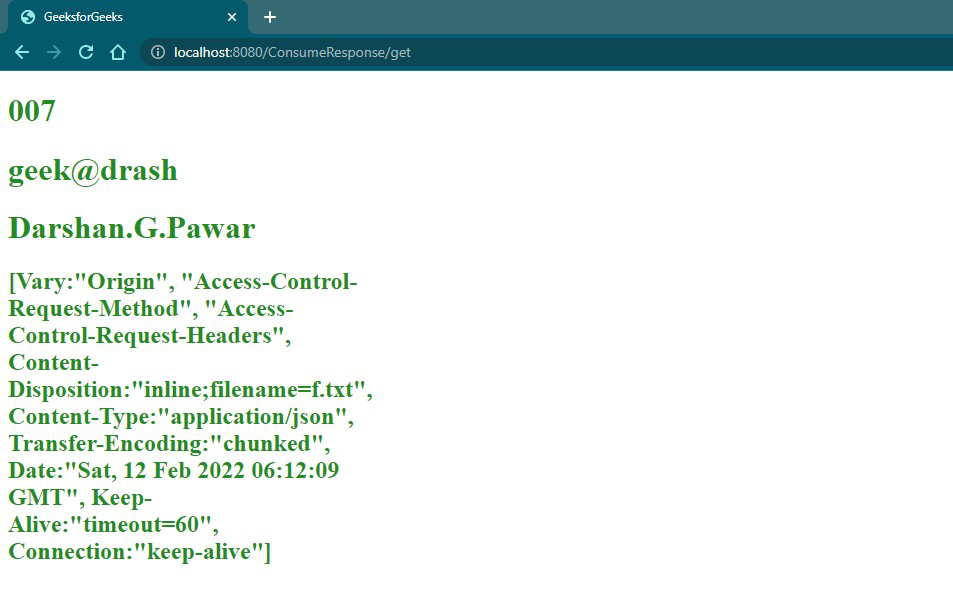
Response with JSON as content type
B: Front-end Application/Framework – Angular
File: consume-json.component.ts ( Angular component )
- This component retrieves the JSON data from the specified URL targeting REST API.
- Retrieved data is stored in a variable.
import { Component, OnInit, Injectable } from '@angular/core';
import { HttpClient } from '@angular/common/http';
@Component({
selector: 'app-consume-json',
templateUrl: './consume-json.component.html',
styleUrls: ['./consume-json.component.css']
})
export class ConsumeJsonComponent implements OnInit {
restData : any;
constructor(private http:HttpClient) { }
ngOnInit() {
this.http.get('http://localhost:8080/JSON/data')
.subscribe(data => this.restData = data);
}
}
File: consume-json.component.html ( view of component)
- Get the stored data by dot( . ) notation.
- ‘ngFor’ is an Angular template directive used for iterating through the collection of objects.
HTML
<h1>Rest API Response : JSON</h1>
<div>
<table *ngFor="let json of restData">
<tr>
<td>{{json.id}}</td>
<td>{{json.name}}</td>
<td>{{json.data}}</td>
</tr>
</table>
</div>
|
File: consume-json.component.css ( Style file )
CSS
h1, tr{
color : green;
font-size : 25px;
}
|
Add - '<app-consume-json></app-consume-json>' in the 'app.component.html' file
Output:
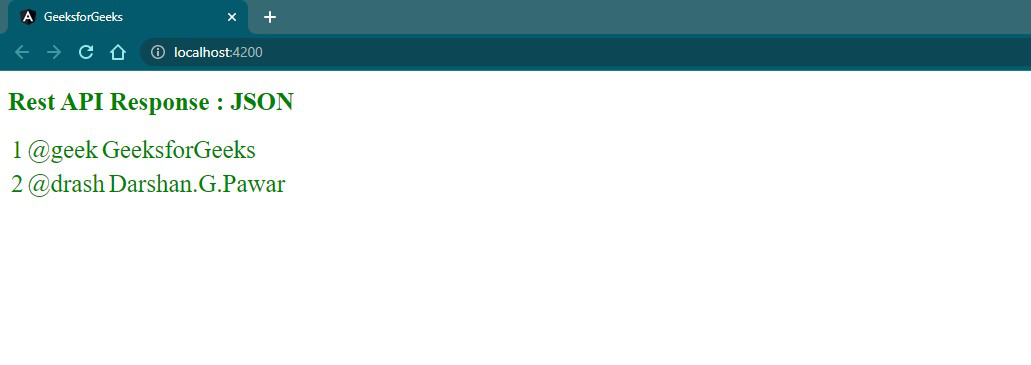
Response retrieved by Angular component
- You can additionally map an object to JSON object literal using the Jackson API.
- Add the following dependency:
Maven -> pom.xml
<dependency>
<groupId>com.fasterxml.jackson.core</groupId>
<artifactId>jackson-databind</artifactId>
<version>2.5.3</version>
</dependency>
Note: This dependency will also automatically add the following libraries to the classpath:
- jackson-annotations
- jackson-core
Share your thoughts in the comments
Please Login to comment...